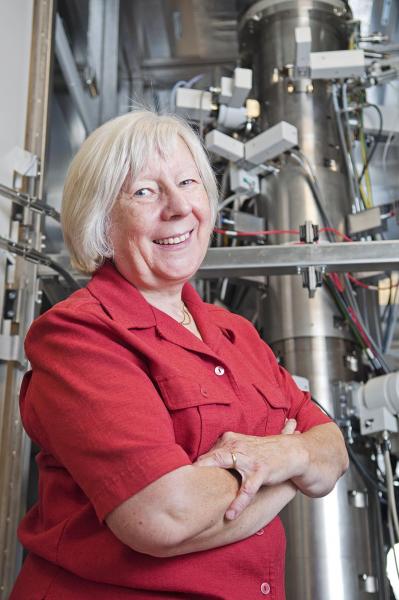Day in the life: Elaine Humphrey
- Kaitlyn Rosenburg

Down in the basement of the Bob Wright Centre, in a room within a room that cannot be disturbed by traffic from nearby Ring Road or the infinitesimally small particle showers of the sun, the diminutive and engaging Dr. Elaine Humphrey is entrusted with the care and operation of the most powerful microscope in the world.
But don’t call it the most powerful microscope in the world in front of her. UVic’s Scanning Transmission Electron Holography Microscope (STEHM) might not be the most powerful—it might not consume the most energy or direct the most powerful beam of any microscope ever built—but with the impassioned delight of an engaged scientist, Humphrey will explain that one of the many things that makes the STEHM microscope so special is that it is the most stable high-spatial resolution microscope ever constructed.
And then Humphrey—laboratory manager and STEHM technologist—will tell you some of the other things that make it both a unique delight and a compelling challenge to work with.
Housed in a temperature-controlled room (currently set at 23°C), with walls lined with cooling and acoustic panels, the Hitachi HF–3300V STEHM microscope, custom manufactured with the assistance and support of the Hitachi corporation, is the first of its kind in the world, and the definite superstar of UVic’s Advanced Microscopy Facility.
And Humphrey’s job, to keep the facility running smoothly, is not a simple task when researchers from across campus and the world are itching to explore the incredible power of the STEHM.
The STEHM can view atoms at picometre resolution. “If you take a millimetre and divide it by 1,000 you have a micron. Divide a micron by 1,000 and you have a nanometer. Divide a nanometre by 1,000 and you have a picometre,” explains Humphrey. “A silicon atom is around 235 picometres.”
Each day in the lab, Humphrey and her assistant Adam Schuetze get to discover the details in everyday things no one ever realized were present. “Quite a lot of firsts in this microscope,” says Humphrey, and adding “We can see atoms any time!”
Humphrey’s journey to UVic began at the University of Southampton in England, where she earned her PhD in Oceanography. Her research on marine snails led her to train on SEM (scanning electron microscope) and TEM (transmission electron microscope) microscopes at Southampton General Hospital. In 1987, she moved to Canada with her family.
In 1992, Humphrey began working part-time at UBC, where she eventually ran the BioImaging Facility. In her spare time, she volunteered at the Vancouver Aquarium and became increasingly interested in hair (sea otter and sloth hair to be exact). Her obsession with hair grew to include the Wool dog, an extinct species First Nations once bred for their long locks.
“Hair’s really interesting,” says Humphrey, who has continued her hair research and hopes to use the SEM for further inquiries into follicles of every kind.
Moving forward, it’s clear Humphrey wants the entire facility to feel welcoming for all. The lab, which began in 2009 as only a concrete floor, will hopefully be open 24/7 in the future.
For now, Humphrey is excited to be training more and more STEHM users. “A lot of people get trained on just the technology, but what you’re taking away is an image. You have to look at it artistically as well,” she says.
Humphrey’s own images have reached well beyond the scientific community. The wildly popular science-fiction television show The X-Files featured her bug images in the series. Five children’s books comprise her stereo SEM pictures.
With Schuetze, she has also created incredible art that requires a microscope to even be seen. One of the microscopes in the lab, the Hitachi FB–2100 Focused Ion Beam system, can act as an extremely precise etching tool. They wanted to see if the entire UVic campus map could be etched onto the head of a pin. “The head of the pin was way too big, so we turned it over onto the point of the pin. You can get five campus maps on there,” says Humphrey.
Humphrey also welcomes new users to the facility regularly. “Using an electron microscope that’s already aligned is very easy,” she believes. While the STEHM may be the world’s most precise microscope, it’s clear a brilliant mind is behind the lens.

